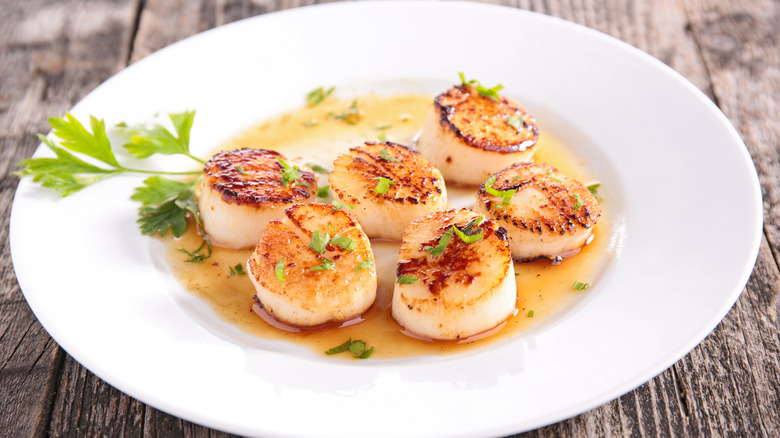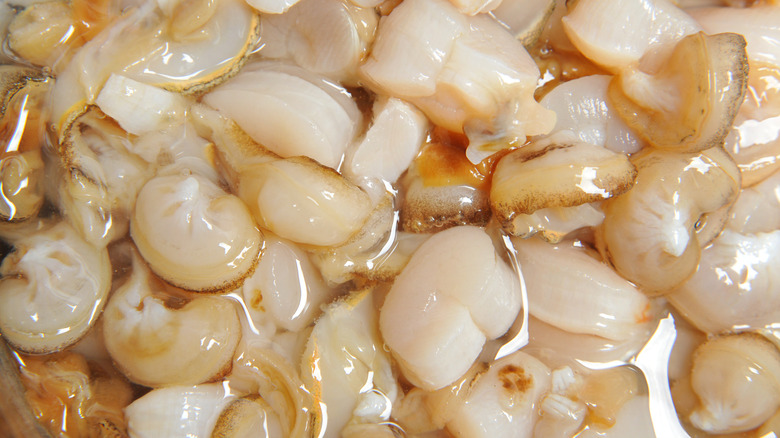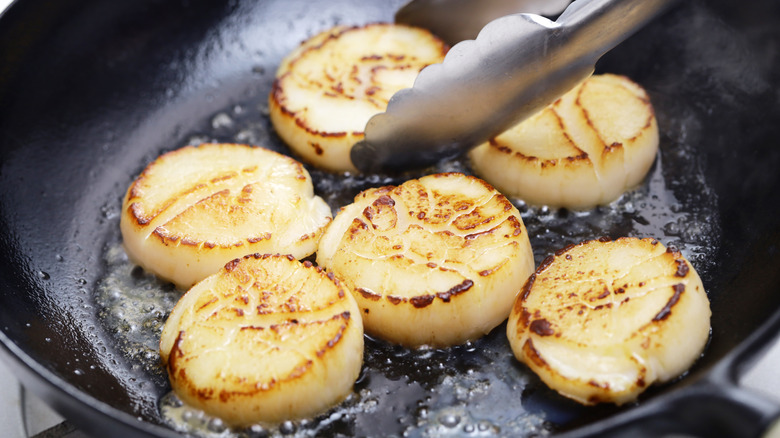The Easily Preventable Mistake That Causes Tough, Chewy Scallops
Scallops are an easy and delicious meal to cook at home, thanks to their sweet flavor, tender texture, and ability to work with a variety of other ingredients. But if you want to enjoy scallops the way that they're meant to be eaten — as fork-tender, delicate morsels that practically melt in your mouth — don't make the cardinal mistake of forgetting to remove the side muscle before cooking them.
You can tell which part is the side muscle because it protrudes from the side of the rest of the scallop flesh. Also known as the foot, the side muscle connects the rest of the scallop to its shell as it moves through the ocean. It has a firmer texture, especially when cooked, which can turn your entire scallop culinary experience into a chewy, rubbery mess. The side muscle is typically a different color from the rest of the scallop, making it easier to recognize. To take the side muscle off, just pinch it between your fingers and pull it away from the scallop. You can discard it or put it aside to simmer in water and seasonings for broth that you can use to add flavor to your scallop dish.
How to prep scallops
When you buy raw scallops at the store, look for fresh options, since these will be the most tender and flavorful. You can find sea scallops in most places that carry fresh seafood, but bay scallops and diver-caught scallops are other options worth trying if you can find them. Scallops are often labeled with the location where they were harvested and they can have slightly different flavor profiles. Good quality scallops should be opaque white and uniform in size, without noticeable torn parts on the edges, although some varieties can be yellowish or even orange.
Most scallops come already prepared, so you might not need to rinse them or trim off the side muscle at all, but you should give them a once-over during the prep process. If you do leave the side muscle on accidentally, you'll get a chewy scallop that is tough to eat. Pull it off with your fingers if needed, then rinse away any dirt, sand, or silt. While the scallops shouldn't come soaking wet, you'll still need to dry them gently before cooking to make sure that they can get a nice sear. Wet-packed scallops work in a pinch, especially if the scallops are not the focal point of your dish, but they tend to be rubbery and less flavorful then their dry-packed counterparts.
Cooking tender scallops
Another mistake that can result in tough scallops is overcooking. Scallops cook quickly in a hot pan, so watch them closely. Once they are dry, you can add a little bit of salt and pepper for seasoning and cook them in oil or butter on medium-high heat. Sear them for around a minute on each side, then take them off the heat to prevent overdoing it.
You can also poach, bake, or grill scallops, and even eat them raw, although they won't get the same crispy exterior and tender interior that comes with a good sear. These cooking methods work well if you want to prepare scallops to use in dishes alongside other ingredients, such as a salad or a seafood medley. Some of the best scallop recipes pair the sweet and tender shellfish with pasta and rice, and some add savory flavors like bacon. Regardless of your chosen recipe, it will taste even better once the side muscle is removed from the scallop.


